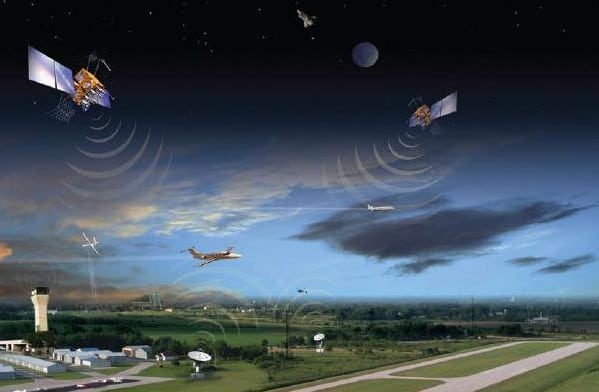[Avionics Today 02-02-2015] The FAA’s third and latest report regarding long-term airport capacity needs stresses the application of NextGen technologies and procedures alongside runway improvements to combat airport congestion and delays in an increasingly crowded airspace. The Future Airport Capacity Task (FACT3) report evaluated the factors and trends that contribute to congestion and delays at busy U.S. airports and explored mitigating factors to avoid future airport capacity restraints, as well as progress that has been made in this area since the first report in 2003. According to the most recent findings, huge hub airports in major cities such as New York and Atlanta may be crowding too quickly for efforts to combat in the next two decades.
 |
| The National Airspace System with NextGen implementation, rendering. Photo: Innopedia |
“While NextGen will improve performance, it’s likely that significant congestion will continue to plague these airports unless additional airfield capacity enhancements can be achieved,” said FAA Administrator Michael Huerta in a letter associated with the report.
FACT3’s report pointed to the success of many NextGen procedures that have been put in place since the last version of the report, FACT2, was released in 2007. These procedures have helped decrease delays at airports such as the Atlanta International Airport (ATL), according to the newly released report. At ATL, Area Navigation (RNAV) flight procedures, alongside a new runway opened in 2006, have worked together to improved airport capacity at this major hub, which has been named the world’s busiest airport by Airport Council International (ACI) annually since 2000.
By 2030, the implementation of midterm NextGen capabilities are “expected to reduce growth and delays at capacity-constrained airports by about 26 percent, with a slight increase in total throughput of up to 2 percent,” according to the report. Still, the FAA is quick to point out that NextGen procedures in themselves, while providing valuable incremental benefits such as moderate throughput increases or the ability to fly more efficient routes, are not enough to slow the effects of rising demand at slammed airports.
“NextGen is helping to manage delays resulting from increasing congestion at many airports, but NextGen alone cannot create sufficient additional capacity at some of the largest and busiest airports,” said Huerta.
ATL, like many airports, is seeing improvements, but isn’t out of the woods yet. It still remains prone to delays as passenger demand skyrockets faster than NextGen and infrastructure improvements can address them. Despite the new procedures in place at ATL, delays are projected to grow throughout 2020 and beyond. This is indicative of other major hub airports identified in the report, including those in New York City, such as La Guardia (LGA) and JFK, as well as Philadelphia (PHL) and, eventually, San Francisco International (SFO) airports at which delays are currently concentrated and expected to grow.
Planned runway extensions at PHL and midterm NextGen capabilities to up efficiency at SFO are expected to mitigate congestion at hub airports and looks combat congestion at these airports in within the next decade. However, projections still forecast that severe delays will result from exploding demand in LGA, JFK and Newark by 2020.
It’s hard to say exactly what the future will bring as demand bumps up against the FAA’s tools to lessen traffic. While NextGen procedures, such as surface metering and decision support tools from improved data sharing, will improve efficiency throughout the entire National Airspace System (NAS) in a somewhat predictable way through 2020, technology in the decade beyond that is difficult to predict.
“Looking further into the future, out to 2030 … with cumulative traffic growth, more hub airports will become congested,” said Huerta. “However, due to aviation industry consolidation and other factors, there is uncertainty with these longer-term projections. For example, the airlines may accelerate the current trend in upguaging to larger aircraft, flying more passengers on fewer flights. With these short-range fluctuations, it’s challenging to determine when long-term capacity enhancements will be needed.”
The long-term outlook calls on more careful monitoring and continued planning efforts to stay ahead of congestion as the middle class grows, the U.S. economy improves, and the demand for flights picks up. And the report remains clear in its recommendations that airports and the agency must look to fight the flood of passenger traffic in every way they can.
“Principally, the findings of this report underscore the continued need for investment in aviation infrastructure,” Huerta said. “Both airport development and NextGen are complementary, of course. Together, they enable efficient, reliable access to the safest and most dynamic aviation system in the world.”